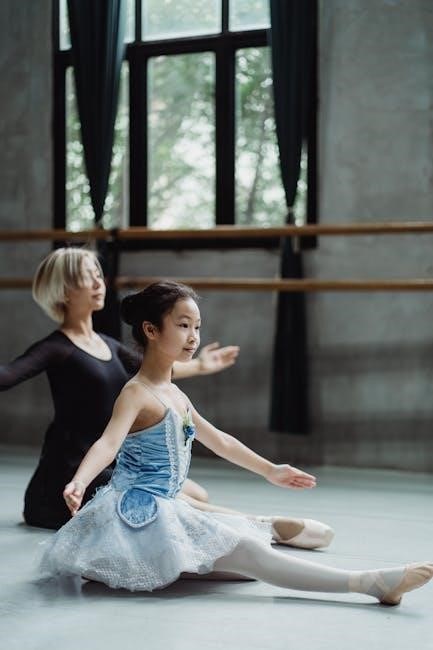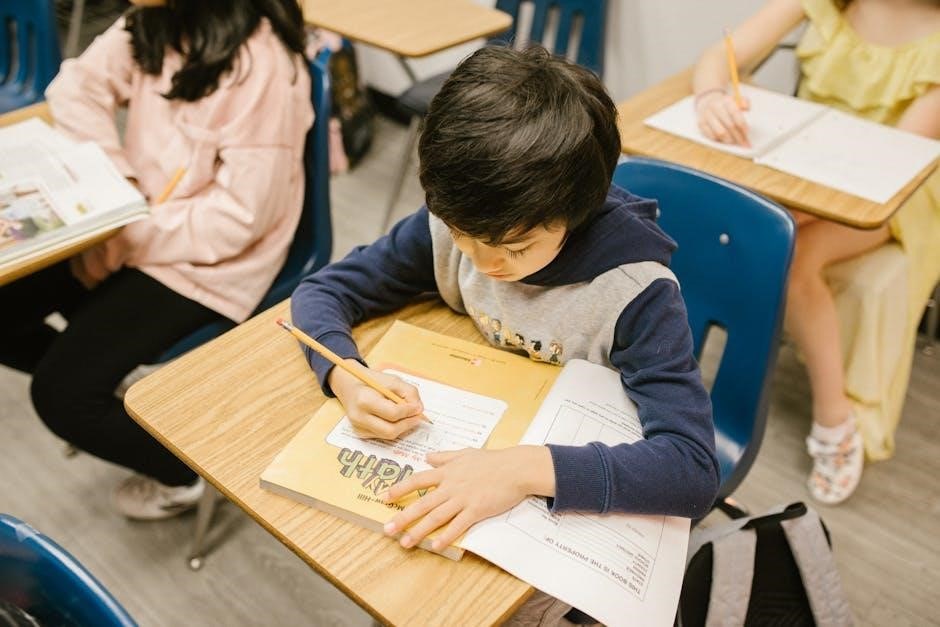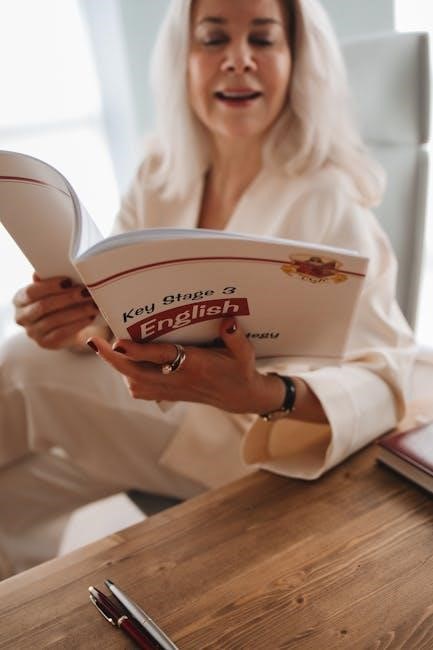Learn-to-skate instructors play a crucial role in teaching foundational skating skills‚ ensuring safety‚ and fostering confidence in students of all ages and skill levels effectively.
Overview of the Instructor’s Responsibilities
Learn-to-skate instructors are responsible for teaching foundational skating skills‚ ensuring student safety‚ and creating an engaging learning environment. They must demonstrate proper techniques‚ provide feedback‚ and adapt lessons to meet diverse student needs. Instructors also manage class dynamics‚ enforce safety protocols‚ and maintain professional certifications. Their role includes preparing lesson plans‚ communicating with parents‚ and fostering a positive‚ supportive atmosphere to help students progress confidently in their skating journey.
Importance of Creating a Positive Learning Environment

A positive learning environment is essential for student success and enjoyment. Instructors foster confidence by encouraging effort‚ celebrating progress‚ and maintaining a supportive atmosphere. This approach helps students feel comfortable taking risks‚ builds their self-esteem‚ and keeps them motivated. A welcoming environment also enhances engagement‚ making the learning process enjoyable and effective‚ which is crucial for skill development and long-term passion for skating.
Essential Skills and Qualifications for Instructors
Instructors must possess strong communication skills‚ patience‚ and the ability to adapt teaching methods for diverse learners. They should be knowledgeable in skating techniques and safety protocols.
Required Certifications (e.g.‚ PSA Membership‚ Level 1 Certification)
Instructors typically need a Professional Skaters Association (PSA) membership and Level 1 Certification‚ which covers teaching methods and safety protocols. Additional requirements include Safe Sport training‚ background checks‚ and liability insurance to ensure a safe and qualified teaching environment for students.
Age and Experience Requirements
Age and experience requirements vary by rink‚ but many programs allow teens as young as 13-16 to assist‚ while qualified instructors are often older with significant skating experience. Typically‚ instructors need at least 1-2 years of skating experience and may require prior teaching or mentoring experience to ensure they can effectively guide students and demonstrate skills confidently.
Necessary Background Checks and Safety Training
Background checks and safety training are essential for instructors to ensure a secure learning environment. Many rinks require instructors to complete SafeSport certification‚ background checks‚ and liability insurance. These measures help protect students and build trust with parents‚ ensuring instructors are qualified and capable of maintaining safety standards while teaching skating skills effectively and responsibly.

Understanding the Certification Process
Certification involves completing specific training programs‚ such as Level 1 Certification‚ which teaches proven methods for safe and effective instruction‚ ensuring instructors are well-prepared to guide students.
Types of Certifications Available for Skate Instructors
Skate instructors can pursue various certifications‚ such as Level 1 Certification‚ which focuses on teaching methods for safe and effective instruction. Additionally‚ PSA (Professional Skaters Association) membership is often required‚ providing access to resources and professional development. Safe Sport certification is also essential‚ ensuring instructors understand and implement proper safety protocols and ethical guidelines in their teaching practices.
Steps to Obtain Level 1 Certification
To obtain Level 1 Certification‚ aspiring instructors must complete Microsoft Learn training modules‚ which are free and available online. These modules cover essential teaching methods and safety protocols. After completing the modules‚ candidates must pass an assessment to demonstrate their understanding. Additionally‚ instructors are encouraged to participate in instructor-led training for hands-on experience and to further prepare for the certification process effectively.
Cost and Duration of Certification Programs
The Microsoft Learn training modules for certification are free‚ making them accessible to all aspiring instructors. The duration varies based on individual pace‚ but completing the modules thoroughly is essential for assessment preparation. While the online modules are self-paced‚ instructor-led training may incur additional costs. The flexibility allows learners to progress at their own speed‚ ensuring a comprehensive understanding of the material before taking the certification assessment.
Safety Protocols and Emergency Procedures
Essential safety equipment‚ proper injury handling‚ and emergency preparedness are critical. Instructors must ensure first aid availability and adhere to safe sport guidelines to protect students and themselves effectively.
Essential Safety Equipment for Instructors and Students
Essential safety equipment includes helmets‚ knee pads‚ elbow pads‚ and wrist guards to protect against falls and injuries. Properly fitted skates with sturdy ankle support are crucial for stability. Instructors should also carry a first aid kit and ensure students wear appropriate protective gear. Additionally‚ whistles or emergency alarms can help signal for assistance when needed during classes or emergencies.
Handling Common Injuries and Emergencies
Instructors must be prepared to handle common injuries like scrapes‚ sprains‚ and bruises by providing immediate first aid. Assess the situation‚ stop bleeding‚ and apply ice if needed. For severe injuries‚ call emergency services promptly. Instructors should maintain a first aid kit and have emergency contact information readily available. Proper training in safety protocols ensures quick‚ effective responses to accidents‚ minimizing harm and ensuring student well-being.
Safe Sport Practices and Guidelines
Instructors must adhere to Safe Sport practices‚ ensuring a secure environment for students. This includes mandatory background checks‚ proper safety training‚ and ethical conduct. Instructors should be prepared for emergencies‚ maintain appropriate boundaries‚ and promote inclusivity. Following these guidelines helps create a respectful and safe space for all participants‚ fostering trust and confidence in the learning process.
Lesson Planning and Class Preparation
Effective lesson planning involves structuring classes to meet student needs‚ using proven teaching models‚ and ensuring clear‚ engaging steps to keep students motivated and progressing smoothly.
Structuring Effective Lesson Plans
Structuring effective lesson plans involves setting clear objectives‚ organizing content logically‚ and incorporating engaging activities. Start with warm-ups‚ followed by skill breakdowns‚ and conclude with cool-downs. Ensure safety protocols are integrated and adapt teaching methods to suit different learning styles and skill levels. This approach keeps students motivated‚ fosters progress‚ and maintains a positive learning environment.
Adapting Teaching Methods for Different Skill Levels
Adapting teaching methods ensures all students‚ from beginners to advanced‚ receive tailored instruction. Use demonstrations for visual learners‚ break skills into smaller steps for novices‚ and incorporate games for engagement. For higher-level skaters‚ introduce complex techniques and challenge them with advanced drills. This approach keeps students motivated‚ ensures progress‚ and fosters a supportive learning environment tailored to individual needs and abilities.
Managing Class Size and Student Engagement
Effectively managing class size ensures personalized attention and safety. Group students by skill level to cater to their needs. Use assistants for larger classes to maintain supervision. Engage students with interactive activities‚ goal-setting‚ and positive reinforcement. Encourage participation and maintain a dynamic‚ inclusive environment to keep students motivated and focused throughout the session.

Communication and Interpersonal Skills
Effective communication is essential for conveying techniques clearly. Instructors should be approachable‚ patient‚ and use positive reinforcement to build confidence. Adaptability ensures understanding across diverse learning styles.
Effective Communication with Students
Effective communication involves clear‚ concise instructions and active listening. Instructors should use positive reinforcement‚ demonstrate techniques‚ and adapt language to suit students’ ages and skill levels. Encouraging questions fosters engagement and understanding. Providing constructive feedback helps students improve while maintaining motivation. Patience and empathy are key to building trust and confidence‚ ensuring a supportive learning environment for all students.
Building Relationships with Parents and Guardians
Building strong relationships with parents and guardians involves regular communication about their child’s progress. Instructors should provide updates on skills mastered and areas needing improvement. Being approachable and open to questions fosters trust. Offering tips for home practice and encouraging parental involvement can enhance learning. Clear‚ respectful communication ensures alignment between instructor and parent goals‚ supporting the student’s overall development and skating journey.
Conflict Resolution Techniques
Conflict resolution techniques for instructors involve staying calm‚ actively listening‚ and addressing issues promptly. Encourage open dialogue to understand concerns and seek mutually beneficial solutions. Remaining professional and empathetic helps de-escalate tensions. If necessary‚ involve rink management or program directors to ensure fair resolutions. Clear communication and respect are key to maintaining positive relationships and resolving conflicts effectively in a skating environment.

Teaching Techniques and Strategies
Effective instructors use clear demonstrations‚ break skills into manageable steps‚ and provide positive feedback to ensure students understand and master techniques confidently and safely.
Breaking Down Complex Skills into Simple Steps
Instructors should deconstruct complex skating skills into basic‚ manageable parts. For example‚ breaking down a crossover into edge work‚ weight transfer‚ and blade placement ensures clarity. Demonstrating each step slowly and providing clear verbal cues helps students understand. Positive feedback and repetition reinforce learning‚ allowing students to build confidence and mastery progressively. This method ensures skills are learned safely and effectively‚ regardless of the student’s initial ability level.
Using Visual Aids and Demonstrations
Visual aids and demonstrations are essential for effective teaching. Instructors can use diagrams or videos to illustrate techniques‚ while live demonstrations provide clear examples. Breaking skills into visible steps helps students understand complex movements. This approach caters to visual learners and reinforces verbal instructions‚ making it easier for students to replicate actions confidently and accurately in a group or individual setting.
Motivating Students to Improve and Stay Engaged
Motivation is key to student progress. Instructors should celebrate small achievements‚ set realistic goals‚ and provide constructive feedback. Creating a positive environment where students feel supported encourages them to push their limits. Incorporating fun activities and varied drills keeps lessons engaging‚ helping students stay motivated and committed to improving their skating skills over time.
Progression and Assessment of Students
Progression and assessment involve tracking student improvement‚ providing constructive feedback‚ and adjusting teaching methods to meet individual needs‚ ensuring each student advances at their own pace.
Setting Realistic Goals for Students

Setting realistic goals involves understanding each student’s abilities and learning pace. Instructors should tailor objectives to individual needs‚ ensuring they are achievable and aligned with skill progression. Celebrating small achievements motivates students and builds confidence. Regular assessments help track development‚ allowing instructors to adjust goals as students improve. Maintaining a positive and supportive environment encourages consistent effort and enjoyment of the learning process.
Assessing Student Progress and Providing Feedback
Regularly assessing student progress involves observing technique‚ tracking skill mastery‚ and evaluating improvement. Providing constructive feedback is essential‚ focusing on specific strengths and areas for growth. Instructors should communicate clearly‚ offering positive reinforcement and actionable advice. This helps students stay motivated‚ understand their development‚ and set achievable goals. Timely and thoughtful feedback fosters improvement and builds confidence in learners of all levels.
When to Advance Students to the Next Level
Instructors advance students when they consistently demonstrate mastery of current skills‚ show readiness for more complex techniques‚ and display confidence in their abilities. Progression is based on individual achievement‚ with clear benchmarks ensuring students are prepared for the next level. Advancement fosters growth‚ keeps lessons engaging‚ and builds motivation‚ helping students reach their full potential effectively.

Marketing and Promoting Your Classes
Effectively market your classes through social media‚ community engagement‚ and partnerships. Highlight student successes and offer trials to attract new skaters‚ utilizing online platforms.
Attracting New Students to Your Program
Attract new students by offering free trial classes‚ showcasing success stories‚ and creating engaging content. Leverage social media platforms like Instagram and Facebook to share videos and testimonials. Partner with local schools and community centers to promote your program. Highlight the fun‚ supportive environment and the expertise of certified instructors to appeal to both children and adults. Word-of-mouth referrals can also significantly boost enrollment rates.
Utilizing Social Media for Promotion
Engage potential students by sharing skating tips‚ success stories‚ and behind-the-scenes content on platforms like Instagram and Facebook. Use hashtags to increase visibility and collaborate with influencers. Post regular updates‚ such as class schedules and testimonials‚ to build interest. Leverage analytics to track engagement and refine your strategy. Sharing videos of lessons and student progress can also attract new participants and showcase your program’s value effectively.

Building a Strong Community Around Your Classes
Foster a sense of belonging by organizing group events‚ such as skate-a-thons or themed sessions. Encourage communication among students and parents through social media groups or newsletters. Recognize achievements and celebrate milestones to boost morale. Creating a supportive environment where skaters of all levels feel valued helps build loyalty and attracts new members through word-of-mouth referrals and positive reviews online.

Continuing Education for Instructors
Staying updated with industry trends and best practices is essential. Instructors can utilize resources like Microsoft Learn and PSA certifications to enhance their teaching skills and knowledge.
Importance of Ongoing Professional Development
Ongoing professional development is crucial for instructors to stay updated on best practices‚ safety protocols‚ and teaching methodologies; Resources like Microsoft Learn and Power BI offer courses to enhance skills‚ ensuring instructors can adapt to new trends and technologies. Continuous learning fosters improved student outcomes‚ keeps classes engaging‚ and maintains the highest standards of instruction in the skating community.
Resources for Further Training and Education
Resources like Microsoft Learn and Power BI offer free training modules to enhance instructors’ skills. These platforms provide step-by-step guidance‚ helping instructors connect with data‚ visualize it‚ and make informed decisions. Additionally‚ traditional classroom settings and online courses allow instructors to learn at their own pace‚ ensuring they stay updated on industry trends and best practices for effective teaching.
Staying Updated on Industry Trends and Best Practices
Staying updated on industry trends and best practices is essential for instructors to deliver effective lessons. Resources like Microsoft Learn and Power BI provide free training modules to enhance skills in data visualization and decision-making. Instructors can leverage these tools to stay informed about the latest teaching methodologies and technologies‚ ensuring they remain competitive and provide high-quality instruction to their students.

Best Practices for Instructors
Maintaining a positive attitude‚ being patient‚ and communicating clearly are key. Adapting teaching methods to meet diverse student needs ensures an engaging and effective learning experience.
Maintaining a Positive and Supportive Attitude
Maintaining a positive and supportive attitude is essential for creating a productive learning environment. Instructors should encourage students‚ celebrate progress‚ and provide constructive feedback. A positive attitude helps build confidence and keeps students motivated. By fostering a supportive atmosphere‚ instructors can help students overcome challenges and enjoy the skating experience. This approach ensures a positive and rewarding journey for all learners.
Encouraging a Growth Mindset in Students
Encouraging a growth mindset helps students view challenges as opportunities to improve. Instructors should praise effort‚ not just success‚ and emphasize that skills develop over time with practice. By focusing on progress and resilience‚ students build confidence and perseverance. This mindset fosters a love for learning and helps students overcome setbacks‚ leading to long-term success in skating and beyond.
Fostering a Love for Skating in Students
Fostering a love for skating involves creating a positive‚ enjoyable environment where students feel inspired and motivated. Instructors should emphasize fun‚ celebrate small achievements‚ and tailor lessons to individual interests. By making skating engaging and rewarding‚ students develop a lifelong passion for the sport‚ leading to increased participation and a stronger skating community overall.
Becoming a learn-to-skate instructor is a rewarding journey that requires dedication‚ patience‚ and a passion for helping others. By fostering a love for skating‚ instructors create lifelong enthusiasts and build a vibrant skating community.
Becoming a successful learn-to-skate instructor requires a combination of certifications‚ safety protocols‚ and effective teaching strategies. Instructors must obtain necessary qualifications‚ adapt lessons to student needs‚ and maintain a positive environment. Continuous professional development and clear communication are essential for fostering student growth and engagement. By following best practices and staying updated on industry trends‚ instructors can create a rewarding and impactful learning experience for all skaters.
Final Tips for Successful Instruction
Be patient‚ positive‚ and encouraging to build confidence. Break skills into simple steps and demonstrate clearly. Use visual aids to enhance understanding. Encourage a growth mindset and celebrate progress. Stay updated on best practices and adapt to student needs. Foster a supportive and inclusive environment to make learning fun and engaging for all skaters.
